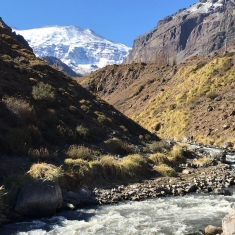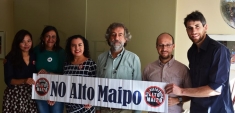Chileans Stand to Defend the Maipo River
From the high, icy glaciers of the Andes Mountains, the waters of three rivers – the Colorado, Yeso and El Volcán – descend to form Chile’s Maipo River. The river is an extraordinary resource for the country, nurturing both wildlife and humans alike.
Upstream, the Canyon of the Maipo is home to precious species including the Andean condor, fox and puma. Downstream, the Maipo flows through the metropolitan region of Santiago, providing drinking water to its six million residents. More than 60% of water for the metropolitan region comes from the Río Maipo River Basin.
But a proposed project is about to threaten all that. The Alto Maipo hydroelectric complex would divert the river, depriving it of its ecological flow for 70 kilometers as its waters are channeled underground for a drainage system of tunnels. It’s estimated that the project will lead to the desertification of 100,000 hectares of the Maipo basin.
Who’s the electricity for? Los Pelambres mine of Antofagasta Minerals is the primary recipient. The project consists of two run-of-the-river dams (531MW), which differ from traditional dams in that they typically require no water storage or reservoir, and are subject to seasonal water flows. Alto Maipo is a project of AES Gener, a Chilean subsidiary of US-based AES Corporation and Antofagasta Minerals, a Chilean company.
Civil society organizations and communities from the Canyon of the Maipo have resolved to fight back. In 2012, they created the No Alto Maipo campaign to oppose the project, arguing that it presents serious threats to irrigation projects and to the supply of potable water for Santiago’s metropolitan region.
Besides organizing protests and teach-ins and presenting legal cases, the campaign also aims to inform and pressure AES and the project financiers. In September, No Alto Maipo sent Marcela Mella, Tomás González and Juan Pablo Orrego, president of Chilean NGO Ecosistemas, to Washington, D.C.
The delegation met with representatives of the Inter-American Development Bank (IDB), Overseas Private investment Corporation (OPIC) and the International Financial Corporation (IFC) from the World Bank. The Chilean delegation pointed out the technical irregularities of the project to the financiers, including the lack of hydrogeological and sedimentation studies, which is in violation of International Financial Institutions (IFI) standards.
The delegation also met with US Department of Treasury, which allocates funds for the World Bank, IDB and OPIC. Orrego’s message was clear. “How can you fund a project that will disrupt the watershed that supplies water to the capital of Chile, with six million people? Chile’s northern and central regions are already suffering from desertification. It is no longer just a drought. And you, the US banks, are financing that!"
Next, the No Alto Maipo campaign intends to present claims before the IDB’s Independent Consultation and Investigation Mechanism (MICI) and the office of the Compliance Advisory Ombudsman of the IFC. The campaign will also seek to pressure the European banks backing the project, such as German’s KFC, Norwegian DNB and other Chilean and Brazilian banks.
Meanwhile, at the Canyon of the Maipo and in Santiago, protests continue. “This fight is not only for not wanting to disturb natural sites,” said María Jesús Martínez Leiva, a member of the Red Metropolitana No Alto Maipo, “but for water and for right of the people of this area to decide how they want to live.”




